Manuel Álvarez Bravo

In Parallel Play at A4 (June 6, 2018–September 27, 2018), Jo Ractliffe pinned Manuel Álvarez Bravo’s photograph Striking Worker Assassinated (1934) to the wall. The artist was in the process of prototyping strategies towards her then-upcoming exhibition, to be held in Oaxaca, Mexico, curated by Ractliffe and Josh Ginsburg. The exhibition formed part of Hacer Noche, a major project of Southern African arts in Oaxaca organised and produced by Francisco Berzunza. Ractliffe titled her exhibition for a note above the door of Manuel Álvarez Bravo’s studio, which reads ‘Hay Tiempo, Hay Tiempo’ (There is Time, There is Time).
For Ractliffe, Álvarez Bravo’s photograph offered not only a distinct visual lexicon but a curious parallel to her image of a dead donkey found on a rural roadside, titled End of Time (1996).
“Your work,” Berzunza told Ractliffe in a conversation held in anticipation of You to Me, Me to You, “I have decided to place together in the exhibition…yours and the Manuel Álvarez Bravo photograph. They go together.” Two figures – one asleep, the other dead – pictured in quiet repose.
b.1902, Mexico City; d.2002, Mexico City
Cautious of political adornment, Manuel Álvarez Bravo opted instead to portray the universal through images of the individual – shop windows, ritual decorations, the surfaces of walls and floors. With his work deeply rooted in indigenous Mexican culture; the artist’s familiarity with surrealism becomes apparent in his explorations of earth, death, and religion. Heralded as the most important figure in 20th-century Latin American photography and a pioneer of artistic photography in Mexico, Álvarez Bravo grasped the medium through the study of photographic journals. It was in these local and international publications that he discovered the work of Edward Weston and Tina Modotti, both of whom became close colleagues and confidantes. At first a student of painting and literature, the years that shaped his career were those following the Mexican Revolution – the documentation of everyday intimacies amidst a rapidly modernising Mexico a recurring theme in his earlier photographs.

